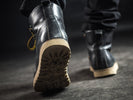
When to Replace Your Work Shoes
, by Ed Stone, 6 min reading time

, by Ed Stone, 6 min reading time
So, how often should you replace work shoes? Your timeline depends on a number of factors, which we’ll touch on below. But by a rough estimate, the average life work shoes have is about 6 to 12 months of regular use. Let’s talk about the reasons why, as well as how to extend that life.
The biggest indicator that your work shoes may need to be replaced is that they have lost some or all of their safety functionality. If a pair of work shoes no longer has the ability to protect you from the elements, or absorb impact or shocks, then they aren’t really safety shoes anymore.
Most commonly, this loss of protective footwear functionality is visible in some combination of:
Let’s take a look at the causes and effects of each.
Some of the most obvious evidence that your work shoes need to be replaced are visible punctures in their uppers, or any other portion of the shoe. These can be the result of individual incidents, such as a tear that forms when a shoe comes in contact with a sharp object.
Or, holes and separation may develop over time with regular use. One classic example of this is separation between the sole and upper, which some people call shoes “talking” to you.
When shoes have holes in them, one major impact on your potential safety is that water, chemical, and temperature resistance may be compromised. In addition, your foot may be exposed to hazards. In the case of separated, “talking” shoes, you may be more likely to trip and fall.
Safety shoes with visible holes, tears, or separation need to be replaced ASAP.
Despite the common phrase “wear and tear,” the impact of wear on your work shoes doesn’t always show up in tears. In many cases, erosion is just as much of an issue as a visible hole or rip in the garment. One of the easiest places to spot this issue is on the soles and midsoles of a shoe or boot, which friction from walking and standing all day can grind away.
With a new pair of work shoes, the bulk of your outsole sole offers added height, comfort walking, and protection from impact. If your sole is wearing thin, a hole or gap is imminent.
Your best bet is getting ahead of the problem and getting a new pair before it’s too late.
As noted up top, there’s no way to extend the lifespan of your work shoes indefinitely. No matter how careful you are, your shoes will eventually begin to age. Over time, even the most rugged shoes will need to be replaced. That said, there are preventive measures you can take.
What you want to do is reduce the shoes’ exposure to harmful elements, by uing the appropriate shoes which includes upper materials and soling materials suitable for specific conditions. Such as environments of varied PH (Acids & Alkalis) levels for both the sole and upper, oil resistant soles, appropriate design of uppers and its materials for particular wear like special leathers, protective overlays, waterproof membranes, heat resistant soles and materials, special designs and materials for climbing poles, trees, etc. You can also limit spreading exposure across multiple pairs
Let’s take a closer look at each method.
The first approach to extending the life of your work shoes involves not wearing them, or being careful about what you do when you wear them. To begin with, you should only wear work boots for work purposes, changing out of them immediately when you leave your job site to prevent worn out work boots.
This also involves common sense solutions, like trying your best to avoid hazards that could harm your shoes (or feet!), like sharp or heavy objects, unnecessary contact with chemicals, etc.
Beyond limiting the amount of time you spend in your boots, you can also make all the time spent in them as safe as possible. For instance, you can apply products that protect against the elements, like snow sealant, or special reparative treatments like toe protection kits. If your boots have experienced wear tear, learn how to restore leather boots.
Another approach that compounds with the one above is actually applying it across multiple pairs of boots. Using more than one good pair of boots in rotation helps to minimize each’s exposure to harmful elements. This keeps all of your pairs safer (and fresher) for longer, since effects from a day’s wear on boots compound with immediate reuse the next day before they air out.
This is also a more economical approach, although that might seem counterintuitive.
For example, imagine buying one pair and wearing them every day. Chances are, they will last you about 6~ months, at which point you’ll need new ones. But if you had bought 2 pairs at the outset and rotated them, each of them would have lasted longer than 6 months.
The best place to find your replacement boots, or even the tools to extend the life of your existing ones, is right here at Boot World. We carry work and safety shoes of every kind, across all of your favorite brands, as well as boot care products for all your shoes. Whether you’re in the market for a new pair of restaurant shoes, work boots, or everyday boots, we’ve got you covered. Plus, our regular and discounted prices can’t be beat, and we offer free shipping on orders over $100.
Get your new favorite work shoes, or repair your current pair at Boot World!